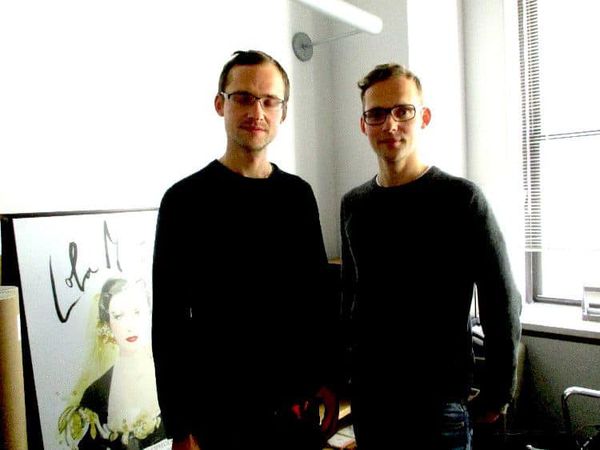 |
| Ramon Zürcher director of The Strange Little Cat, with producer Silvan Zürcher on the left: "I was always fascinated very much by films of Ingmar Bergman because they deal with inner states." |
Find out what Lucrecia Martel's The Headless Woman, the interior in Ingmar Bergman, Audrey Hepburn in Breakfast At Tiffany's, Hitchcock's Rear Window basket and Ernst Jandl's poems have to do with Ramon Zürcher's The Strange Little Cat (Das merkwürdige Kätzchen).
Following a press screening of Jacques Demy's Young Girls Of Rochefort, I met up with Zürcher. In the center of Demy's marvelous and innovative musical which features a pastel clad vision of Gene Kelly, are twins, played by Catherine Deneuve and her late sister Françoise Dorléac. In perfect symmetry, Ramon brought along his twin brother, producer Silvan Zürcher to the office of Criterion Collection, off Union Square, where our conversation took place, arranged by the Film Society of Lincoln Center's David Ninh.
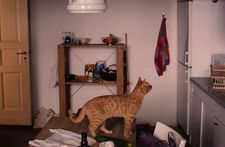 |
| The Strange Little Cat: "Your perception always has to be so awake as if you could lose something." |
MoMA Department of Film Curator Jytte Jensen told me earlier this year during the New Director/New Films program about Zürcher's debut feature film that "formally it's so inventive and you tend to, when you talk about it initially, just talk about the form. And you miss the point of how emotionally involving and revealing it is of all the people in this kitchen."
Anne-Katrin Titze: You have an interesting equality in showing human beings and animals and inanimate objects. You give us a choice to think about the oranges or the person, or go with the cat. How were you mapping out those? The little girl Clara (Mia Kasalo) wears a shirt that matches the color of orange juice exactly.
Ramon Zürcher: Actually from the beginning it was like a model house. There were elements like the characters, the animals, objects, sentences, music. It was like playing in a model house and then using the objects and the animals and also the characters with appearances that have an emotional quality. For example, Clara's grocery shopping list.
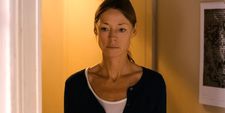 |
| Jenny Schily as Mother: "wrapped in stillness and absence of life." |
First she writes it, then Karin (Anjorka Strechel) corrects it, then the mother clutches it, later Clara throws it on the cat. So the object has a development through the day. It changes. There are traces of actions on it and traces of time. So the grocery shopping list gets to be a character. Putting the animals and objects somewhere is really giving them a value. We have those shots of them which give them a presence and treat them like the humans.
AKT: Twice in your film I thought about very specific scenes from other movies. The basket that is coming down outside the house reminded me of Hitchcock's Rear Window. The other one was the mother's favorite place - that's her Breakfast At Tiffany's.
RZ: You are the first one who had those connections. Is in Rear Window a bag pulled up outside?
AKT: No, it's a little dog that the couple across transports in a basket up and down. In your case, you have the rat downstairs, the cat's interest and the fat neighbour who gets groceries up on a rope. The other one is Audrey Hepburn on Fifth Avenue having breakfast, calling Tiffany's her favorite place. In your film there is this very different place the mother goes to to find peace. Were there films or filmmakers that influenced yours?
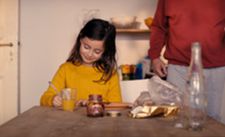 |
| Mia Kasalo as Clara, making her grocery list: "So the grocery shopping list gets to be a character." |
RZ: Often it's not only films I like so much but also those I hate. I was always fascinated very much by films of Ingmar Bergman because they deal with inner states. Interior feelings, the psyche. For me, the visual medium of film is so interesting. To take the exterior, something like this room, which is visible and very concrete, and to use it and make an inner space, an interior. A concrete sensual motivational culture of the psyche - that in fact always fascinated me in the films by Ingmar Bergman. Also the degree of stylisation. I don't like so much anything naturalistic or hand-held cameras.
In contemporary cinema, I was fascinated by the last films by Lucrecia Martel. For example in The Headless Woman where the mise-en-scène of that chaos creates that chaotic space with the sounds and the hidden plot. It's so weak, the hidden plot, you're lost in it. Your perception always has to be so awake as if you could lose something. You're lost in that universe.
AKT: Lucrecia Martel is great with chaos. You locate the chaos for the family you show in this super bland Berlin apartment.
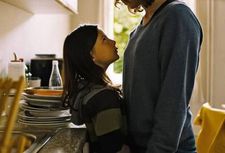 |
| Clara, the strange little girl: "Clara is very vivid, naturalistic." |
RZ: It's so anti chaotic, it's so boring. I didn't want it to look like punk or like anarchy. Very like the bourgeoisie, middle class. It's a chain of performances happening.
AKT: Tell me about your use of language. Some of the dialogue reminded me of Ernst Jandl poems, Otto's Mops for example [Jandl's poem about Otto's pug uses only the vowel 'o']. In your film people say: "Is Clara nuts? Yes. Is the cat nuts? Yes."The poetic parts do shift with very day-to day real life German. How did you mix the levels?
RZ: The audiences in Germany also remarked that some sentences are closer to literature or theatre or thinking. Sometimes it is more like poems or lyrics from songs with a certain repetition. Other texts were rather naturalistic. When they sit and eat at the end of the film, there are off dialogues which the actors just improvised. It's very naturalistic like the color of life. Because I'm Swiss, for me the German is a very artificial language. For me every day language is Swiss German. I'm interested to model the language, maybe like the camera. The camera doesn't give the illusion of naturalism or authenticity and neither does the language. It would fit better on the stage of a theatre and I am using it also in film.
AKT: I like how you are using both.
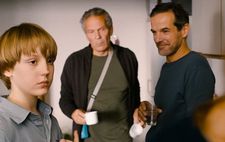 |
| The Strange Little Cat family: "At any time a certain violence could be possible, that was very quickly an important part of the universe of that family." |
RZ: It also depends on the acting of the performers. Like Clara is very vivid, naturalistic. The performance of the mother is rather stylised because it is wrapped in stillness and absence of life. So it's kind of a balance between movement and stillness. None of the characters are at the same degree of movement.
AKT: The stylised performance of the mother is that threat we get from her. She seems ready to explode at any moment. Was the title always The Strange Little Cat?
RZ: It was always called The Strange Little Cat.
AKT: Your film is difficult to describe. Can you talk about the form?
RZ: Yes, what we knew from the beginning was the structure, that it would be a chamber piece. It has a very strict structure but inside that very strict structure, inside that prison of time and prison of apartment, there was an openness, a certain liberty. It was never a kind of slavery of story. Never a story told from beginning to the end. I think oftentimes to describe a film you describe the story, what is happening, because it's the most concrete thing. It's the most communicative thing with the audience.
AKT: You leave a lot for the spectators to figure out while watching. There is a sense of trust that we will figure out who these relatives are. There is the repairman coming, and you signal us not to worry, we'll figure out who he is if necessary. The beauty of the film is that we settle in the not knowing and can focus on other aspects.
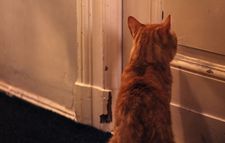 |
| The Strange Little Cat: "Never a story told from beginning to the end." |
RZ: Actually, the writing was rather like automatic writing, écriture automatique, that strategy of the Surrealists. The topic was not there at the beginning and then you found things which deal with that topic. Mostly a topic or a story is what makes a film easy to consume so that head and heart deal with it. But there was neither a topic at the beginning, nor a story. It was created and constructed very intuitively. That way of story writing and of constructing an audio-visual universe makes it kind of unpredictable and difficult to describe an atmosphere.
AKT: There is a menace in the film, which might have something to do with the structure you described. Right from the start we feel the menace in the family's every day situations. "If you don't feed the sparrows, they are all going to die", is a threatening line to a child. Twice a foot is very close to the cat's head. Did the menace come out of the automatic writing or did it get special placement?
RZ: During the writing, things appeared and we consciously put them in. There's menace, or the possibility of violence, not only physical violence but also psychological violence. At any time a certain violence could be possible, that was very quickly an important part of the universe of that family. It was something we were very much interested in. It has to do with the character of the mother (Jenny Schily) who during the scriptwriting became kind of the protagonist. I think there is also a basic interest in rather dark sides of human beings. I can identify better with those rather dark sides. I have a certain proximity to each character and feel close to them with those dark aspects.
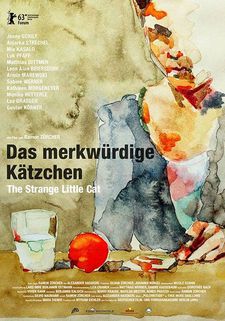 |
| The Strange Little Cat (Das merkwürdige Kätzchen) poster |
AKT: The dark aspects never explode. You go close to them but not too close. We provide our own. For example, when the mother tells the story she experienced sitting in the cinema next to a stranger, it raises our expectations. It turns out to be a foot on a foot and grandmother (Monika Hetterle) waking up. Are you interested in your spectators' darkness as well?
RZ: Maybe. If it's a universe with that kind of emotion, according to the mood and atmosphere, then, of course, the spectator has to deal with it. Either to read and feel it or to deny and not perceive it. The spectator has to...
AKT: Take a position? You cannot not position yourself in this film.
RZ: Yes, take a position. Because of the openness. It's not that you have a string on which you can walk through the film. Each spectator focuses on other things. You walk through the film and there is so much happening at the same time. Different spectators focus on the sound, on the dialogue, others on the action. Then there is that on-screen/ off-screen conflict. It can be like two films at the same time and it's not so easy to consume. Because of the conflict of sound and action sometimes the ear and sometimes the eye is more important.
The Strange Little Cat opens for an exclusive, one week engagement at the Film Society of Lincoln Center in New York on August 1.





















